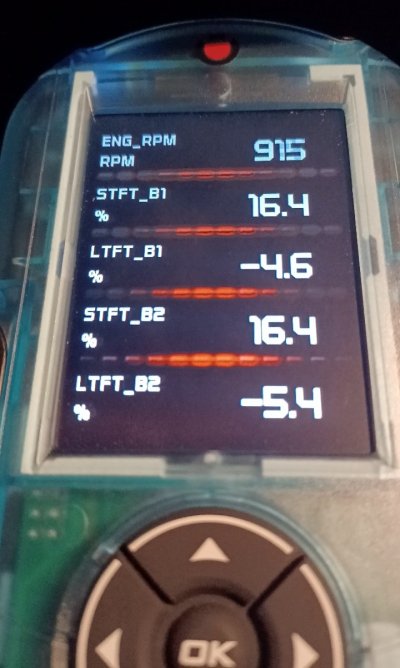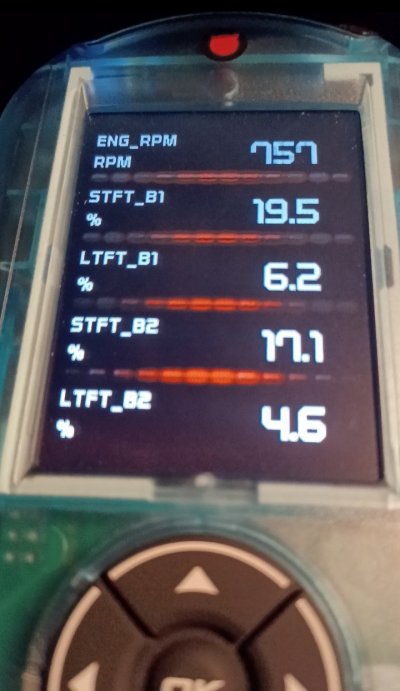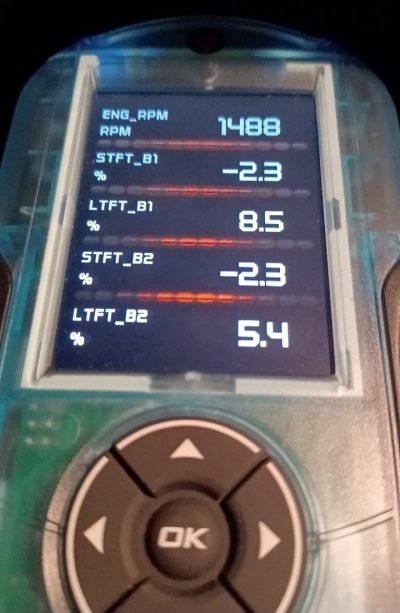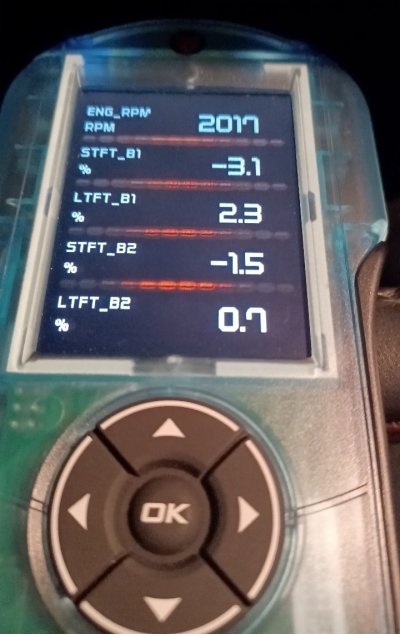CruelJung
Member
- Joined
- Jul 11, 2022
- Posts
- 46
- Reaction score
- 58
I have seen other posts about similar issues to what I'm experiencing, but I haven't been able to glean any solutions from them as of yet. However, I've been doing what I can and collecting information over the past month, so hopefully the process of elimination has a head-start.
Issue In Question:
I live in a warm climate and back in December the temperature dropped unusually low (mid-30's) overnight and was still hovering around 45 °F when I needed to start my vehicle in the morning. I remote-started it from distance to give it extra time to warm up and noticed it was running rough. While I loaded some gear, with remote-start still going, the engine shut off. I pulled out my Diablo tuner and and checked for codes: I had P0300, P0171, and P0174. I cleared the codes and started the engine again, to the same rough idle effect, and decided to rev the engine a bit a see if there was any improvement. While doing so relieved the engine's struggles, the RPMs were rising well above my pedal pressure and remaining for minutes where they stopped even after I released the pedal before finally dropping. I continued this process, for better or worse, until the engine warmed up to about 160 °F and the engine evened out to normal idle and throttle response. During that process, the dash regained codes P0171 and P0174 (not P0300). Out of sheer necessity, I took my vehicle to the intended destination (regaining only P0300 again on the trip), starting the vehicle again several hours later and having to go through a slightly less intense revving process to warm up the engine without stalling and driving it home.
Since this occurred, I have been continuing the above process to warm up the engine when the weather is on the colder side--the intensity of the rough idle and length of warm up process being mirrored by the degree of cold weather. Also, since the initial day of this flare-up, I have not regained the random misfire CEL. Lean codes for bank 1 and 2 (171 & 174) continued.
Further Background:
Before I get into what I have done in response, it's worth noting that my engine has been exhibiting--to an extremely minor degree--some of this rough idle at cold crank (seemingly regardless of weather) since I acquired it two years ago. At cold crank, the engine typically revs just above 1000 RPMs and settles down to stock idle within 30 seconds. Sometimes the engine vibrates a bit more than other times, but it's all over in a matter of seconds and smooths out to what I understood (with my lack of familiarity) to be normal. Similarly, when in drive while I am waiting at a light, I can feel intermittent vibration; it's not what I would consider to be a rough idle, but it's not perfectly smooth. None of the above trouble codes have been associated with these *features,* but I was getting codes P01153 and P01133 early in my ownership, which led me to replace both upstream O2 sensors. The O2 sensors' replacements did not immediately stop the 1153/1133 code recurrence, but over the months following that work--possibly in conjunction with me adding P.I. (Amsoil) to my fuel tank in regular intervals--these "insufficient switching" codes ceased. My dash had been clean of any CELs for several months to a year (I've had a bit too much going on in my life to remember, precisely) by the time this cold weather rough idle problem presented itself at the end of last year.
What I Have Done Since The Event In December:
1. Cleaned MAF sensor (with CRC MAF sensor cleaner) & replaced air filter (high pleat count, AC Delco).
2. Updated driver side valve cover install.
3. Catch can install & replacement rubber elbow (valve cover to PCV line fitting). The latter was cracked, as I found while installing the OCC. Since replacing the elbow I have not had any more CELs/codes, although a lessened rough idle at cold crank in cold weather persists.
4. Checked for tightness of air intake fittings excluding throttle body to intake manifold--I plan to, but have not yet purchased click-style torque wrenches, and I only have an old beam-style wrench that I don't trust.
5. Cleaned throttle body bore and blade (with CRC MAF sensor cleaner) via weight on accelerator pedal while key in "on" position--I read some horror stories of idle issues following other methods. Throttle body was dirty, but not too bad. I noticed liquid shimmering in the back of the intake manifold while the TB was open (pre-OCC development?).
6. Cleaned MAP sensor (CRC MAF sensor cleaner) and replaced silicone sleeve around nipple. After this was done, a new symptom appeared: my idle, while in drive and stopped at lights, began erratically dipping just beneath 500 RPMs before quickly rising back up to stock RPMs. The engine would not stall, but felt close to doing so when the RPMs dropped.
7. Raised both park and drive idle to +150 RPMs from stock value via Diablo (Predator 2) tuner. I presumed both values in stock form were identical and that raising them equally would keep them equal, but the result of this modification has raised my "park" idle to 750 RPMs while my "drive" idle remains at just above 500 RPMs (perhaps only slightly higher than before). My "drive" idle no longer dips below 500 RPMs or feels as though it will stall, but the needle still fluctuates slightly up and down.
8. Performed Seafoam Top Engine cleaning procedure through throttle body. Minimal smoke, relative to what results I've seen from others, but what I expected with a port injection engine.
Live Data Observations Via Diablo Tuner:
1. MAF sensor shows +/- values per acceleration.
2. MAP sensor shows +/- values per acceleration.
3. Accelerator pedal shows +/- values per pedal pressure
4. Throttle body duty % does not mirror pedal pressure values*
Final Notes:
*I've been contemplating, based on findings in these forums, that my issue is narrowing down to either the accelerator pedal/sensor assembly or throttle body/TPS--leaning towards the entire TB or TPS because the live data APP values seem to reflect actual applied pedal pressure, while even with my pedal at 100% the TB was showing--at max, with key in "on" position--20%.
There is absolutely no trouble in starting the vehicle, so when I mention a rough idle I mean in no way a hard start (my spark plugs and wires are new as of early 2021--if that matters--as is/are the thermostat, water pump, serpentine belt, and upper/lower heater hoses).
Another vexing aspect of all this to me is that every time I see someone solved or came close to solving issues like these, trouble codes more specific to their solutions seem to be present. I probably could have tried replacing the MAF and MAP sensors by now (or the fuel pump, for that matter), but I wanted to explore everything before part swapping--especially since I have experienced some improvement along the way and no CELs are presenting themselves anymore.
I have a family mechanic with an expensive and high end scan tool/computer, another mobile mechanic available with unspecified scanning equipment and expertise, and I'm sure there's more for me to learn about this Diablo scanner/tuner of mine, so please weigh in on what else I can do to troubleshoot and what you think about the current findings.
Thank you!
Issue In Question:
I live in a warm climate and back in December the temperature dropped unusually low (mid-30's) overnight and was still hovering around 45 °F when I needed to start my vehicle in the morning. I remote-started it from distance to give it extra time to warm up and noticed it was running rough. While I loaded some gear, with remote-start still going, the engine shut off. I pulled out my Diablo tuner and and checked for codes: I had P0300, P0171, and P0174. I cleared the codes and started the engine again, to the same rough idle effect, and decided to rev the engine a bit a see if there was any improvement. While doing so relieved the engine's struggles, the RPMs were rising well above my pedal pressure and remaining for minutes where they stopped even after I released the pedal before finally dropping. I continued this process, for better or worse, until the engine warmed up to about 160 °F and the engine evened out to normal idle and throttle response. During that process, the dash regained codes P0171 and P0174 (not P0300). Out of sheer necessity, I took my vehicle to the intended destination (regaining only P0300 again on the trip), starting the vehicle again several hours later and having to go through a slightly less intense revving process to warm up the engine without stalling and driving it home.
Since this occurred, I have been continuing the above process to warm up the engine when the weather is on the colder side--the intensity of the rough idle and length of warm up process being mirrored by the degree of cold weather. Also, since the initial day of this flare-up, I have not regained the random misfire CEL. Lean codes for bank 1 and 2 (171 & 174) continued.
Further Background:
Before I get into what I have done in response, it's worth noting that my engine has been exhibiting--to an extremely minor degree--some of this rough idle at cold crank (seemingly regardless of weather) since I acquired it two years ago. At cold crank, the engine typically revs just above 1000 RPMs and settles down to stock idle within 30 seconds. Sometimes the engine vibrates a bit more than other times, but it's all over in a matter of seconds and smooths out to what I understood (with my lack of familiarity) to be normal. Similarly, when in drive while I am waiting at a light, I can feel intermittent vibration; it's not what I would consider to be a rough idle, but it's not perfectly smooth. None of the above trouble codes have been associated with these *features,* but I was getting codes P01153 and P01133 early in my ownership, which led me to replace both upstream O2 sensors. The O2 sensors' replacements did not immediately stop the 1153/1133 code recurrence, but over the months following that work--possibly in conjunction with me adding P.I. (Amsoil) to my fuel tank in regular intervals--these "insufficient switching" codes ceased. My dash had been clean of any CELs for several months to a year (I've had a bit too much going on in my life to remember, precisely) by the time this cold weather rough idle problem presented itself at the end of last year.
What I Have Done Since The Event In December:
1. Cleaned MAF sensor (with CRC MAF sensor cleaner) & replaced air filter (high pleat count, AC Delco).
2. Updated driver side valve cover install.
3. Catch can install & replacement rubber elbow (valve cover to PCV line fitting). The latter was cracked, as I found while installing the OCC. Since replacing the elbow I have not had any more CELs/codes, although a lessened rough idle at cold crank in cold weather persists.
4. Checked for tightness of air intake fittings excluding throttle body to intake manifold--I plan to, but have not yet purchased click-style torque wrenches, and I only have an old beam-style wrench that I don't trust.
5. Cleaned throttle body bore and blade (with CRC MAF sensor cleaner) via weight on accelerator pedal while key in "on" position--I read some horror stories of idle issues following other methods. Throttle body was dirty, but not too bad. I noticed liquid shimmering in the back of the intake manifold while the TB was open (pre-OCC development?).
6. Cleaned MAP sensor (CRC MAF sensor cleaner) and replaced silicone sleeve around nipple. After this was done, a new symptom appeared: my idle, while in drive and stopped at lights, began erratically dipping just beneath 500 RPMs before quickly rising back up to stock RPMs. The engine would not stall, but felt close to doing so when the RPMs dropped.
7. Raised both park and drive idle to +150 RPMs from stock value via Diablo (Predator 2) tuner. I presumed both values in stock form were identical and that raising them equally would keep them equal, but the result of this modification has raised my "park" idle to 750 RPMs while my "drive" idle remains at just above 500 RPMs (perhaps only slightly higher than before). My "drive" idle no longer dips below 500 RPMs or feels as though it will stall, but the needle still fluctuates slightly up and down.
8. Performed Seafoam Top Engine cleaning procedure through throttle body. Minimal smoke, relative to what results I've seen from others, but what I expected with a port injection engine.
Live Data Observations Via Diablo Tuner:
1. MAF sensor shows +/- values per acceleration.
2. MAP sensor shows +/- values per acceleration.
3. Accelerator pedal shows +/- values per pedal pressure
4. Throttle body duty % does not mirror pedal pressure values*
Final Notes:
*I've been contemplating, based on findings in these forums, that my issue is narrowing down to either the accelerator pedal/sensor assembly or throttle body/TPS--leaning towards the entire TB or TPS because the live data APP values seem to reflect actual applied pedal pressure, while even with my pedal at 100% the TB was showing--at max, with key in "on" position--20%.
There is absolutely no trouble in starting the vehicle, so when I mention a rough idle I mean in no way a hard start (my spark plugs and wires are new as of early 2021--if that matters--as is/are the thermostat, water pump, serpentine belt, and upper/lower heater hoses).
Another vexing aspect of all this to me is that every time I see someone solved or came close to solving issues like these, trouble codes more specific to their solutions seem to be present. I probably could have tried replacing the MAF and MAP sensors by now (or the fuel pump, for that matter), but I wanted to explore everything before part swapping--especially since I have experienced some improvement along the way and no CELs are presenting themselves anymore.
I have a family mechanic with an expensive and high end scan tool/computer, another mobile mechanic available with unspecified scanning equipment and expertise, and I'm sure there's more for me to learn about this Diablo scanner/tuner of mine, so please weigh in on what else I can do to troubleshoot and what you think about the current findings.
Thank you!
Last edited:




